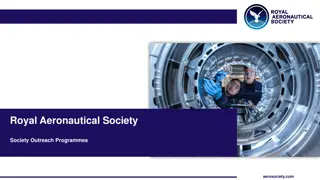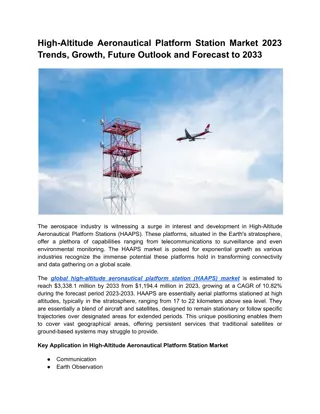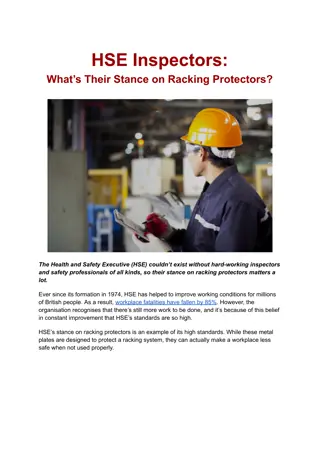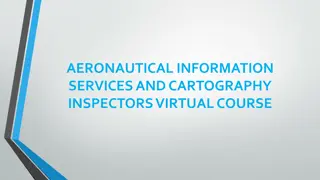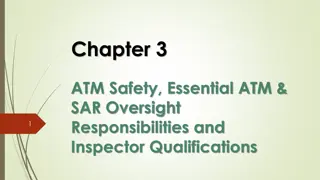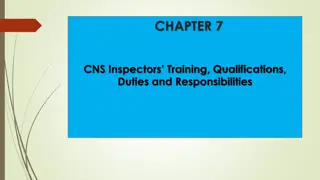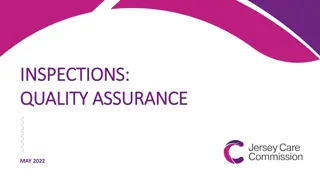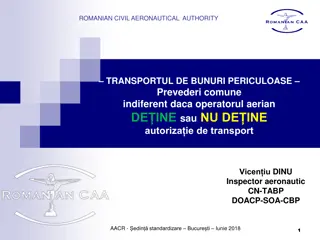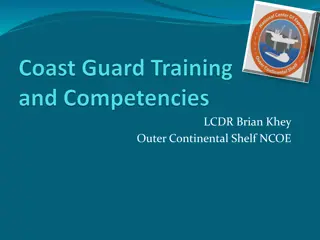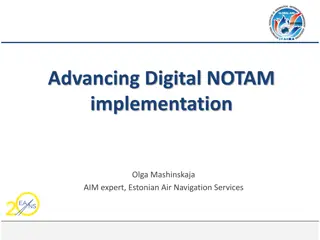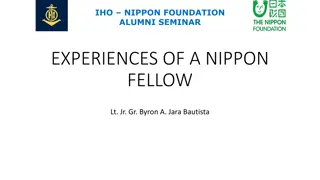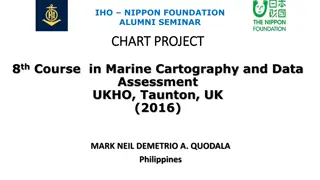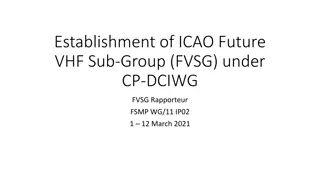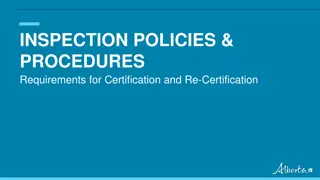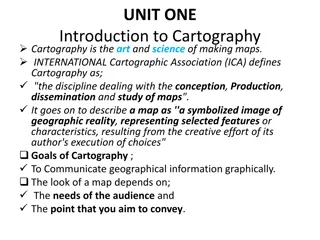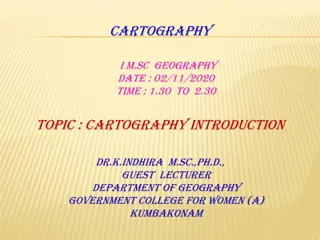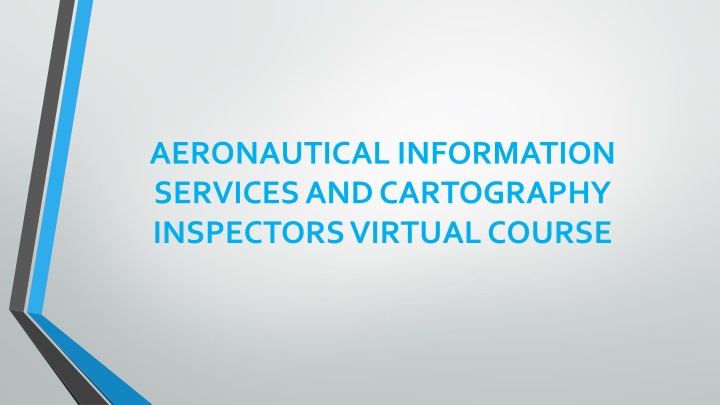
Aeronautical Information Services & Cartography Inspectors Course
This virtual course covers aviation safety oversight, regulations, competency assessment, enforcement, and more for AIS and cartography inspectors. Participants will gain knowledge on ICAO safety oversight, audit processes, resolution of safety issues, and enforcement actions. The course aims to enhance skills in developing regulations, conducting audits, and ensuring compliance in the aviation sector.
Download Presentation

Please find below an Image/Link to download the presentation.
The content on the website is provided AS IS for your information and personal use only. It may not be sold, licensed, or shared on other websites without obtaining consent from the author. If you encounter any issues during the download, it is possible that the publisher has removed the file from their server.
You are allowed to download the files provided on this website for personal or commercial use, subject to the condition that they are used lawfully. All files are the property of their respective owners.
The content on the website is provided AS IS for your information and personal use only. It may not be sold, licensed, or shared on other websites without obtaining consent from the author.
E N D
Presentation Transcript
AERONAUTICAL INFORMATION SERVICES AND CARTOGRAPHY INSPECTORS VIRTUAL COURSE
COURSE CONTENT Aviation Safety Oversight and the USOAP-CMA; The AIS and Cartography Safety Oversight Development and Review Regulations and other Oversight Documentation Tools used in AIS and Cartography oversight Audit/Inspection of an AIS and Cartography Providers Post-Audit Activities and audit/inspection Outcomes AIS and Cartography Competency Assessment and Certification (CE - 6) Continuous Surveillance of an AIS and Cartography provider (CE -7) Resolution of AIS and Cartography safety issues (CE -8) Enforcement of AIS and Cartography Related Standards and Regulations (CE -8)
COURSE OBJECTIVES At the end of this course the participant should be able to: Describe the ICAO Safety Oversight function and the USOAP/CMA; Demonstrate an understanding of the State Safety Oversight including the AIS and Cartography Inspector Roles within the Oversight organization Understand the duties and responsibilities an AIS and Cartography Inspector; Develop and Review Regulations, Guidance Material and other oversight documentation Develop and effectively utilize the tools used for the oversight of AIS and Cartography Service Providers; Conduct an Audit of an AIS and Cartography Service provider; Write and disseminate an audit report and undertake follow-up activities; Be able to undertake Resolution of safety issues and enforcement actions
CHAPTER ONE An Overview of the ICAO Aviation Safety Oversight and the USOAP-CMA
Definitions Audit. A systematic, independent and documented process for obtaining evidence and evaluating it objectively to determine the extent to which requirements andaudit criteriaare fulfilled. Authorized person. A person authorized in writing by the Director General of Civil Aviation or equivalent official to act under the provision in which the expression occurs. Inspection. An examination of specific activities, products or services of an aviation licence, certificate, approval or authorization holder (or applicant) performed by civil aviation inspectors to confirm compliance with requirements for the licence, certificate, approval or authorization already issued (orbeing issued)bytheState.
Definitions Effective implementation (EI). A measure of the State s safety oversight capability, calculated for each critical element, each audit area or as an overall measure (expressed as apercentage). Finding. Generated in a USOAP CMA activity as a result of a lack of compliance with Articles of the Convention, ICAO Assembly Resolutions, safety-related provisions in the Annexes to the Convention, Procedures for Air Navigation Services (PANS) or a lack of applicationofICAOguidancematerialorgoodaviationsafetypractices. Lack of effective implementation (LEI). A measure of the State s lack of safety oversight capability, calculated for each critical element, each audit area or as an overall measure. TheLEIis expressed asapercentage.
Definitions Inspector. A qualified person authorized by the State to carry out oversight activities for civil aviation. Legislation. Generic term used to include primary aviation legislation and specific operating regulations, as defined in Critical Elements 1 and 2 of a State safety oversight system, respectively. Safety. The state in which risks associated with aviation activities, related to, or in direct support of the operation of aircraft, are reduced and controlled to an acceptable level.
Definitions Safety oversight. A function performed by a State to ensure that individuals and organizations performing an aviation activity comply with safety-relatednational lawsand regulations. Service provider. An organization providing aviation products and/or services. The term thus encompasses approved training organizations, aircraft operators, approved organizations responsible for type design or manufacture of aircraft, engines or propellers, air traffic service providers and other air navigation serviceprovidersand aerodromeoperators. maintenance organizations,
Definitions Quality. Degree to which a set of inherent characteristics fulfils requirements. Quality assurance. Part of quality management focused on providing confidencethat quality requirementswillbefulfilled. Quality control. Part of quality management focused on fulfilling quality requirements. Quality management. Coordinated activities to direct and control an organization with regardtoquality.
Convention on International Civil Aviation Convention on International Civil Aviation (also known as Chicago Convention) -signed on 7 December 1944; Provides an anchor of the Safety oversight function; established to promote cooperation and create and preserve friendship and understanding among the nations and peoples of the world; agreement established the core principles permitting international transport by air, and led to the creation of the specialized agency which has overseen it ever since -ICAO
Convention on International Civil Aviation Contains certain principles and arrangements agreed upon by States in order that international civil aviation may be developed in a safe and orderly manner and that international air transport services may be established on the basis of equality of opportunity and operated soundly and economically; Convention s core mandate, is to help States to achieve the highest possible degree of uniformity in civil aviation regulations, standards, procedures, and organization; the Convention s Annexes have increased in number and evolved such that they now include more than 12,000 international standards and recommended practices (SARPs), all of which have beenagreed byconsensus byICAO s now 193 MemberStates;
Convention on International Civil Aviation Standards and Recommended Practices are set out in 19 Annexes to theConvention Cover all technical and operational aspects of civil aviation; Standards are technical specifications, the uniform application of which is necessary for the safety or regularity of international civil aviation Recommended Practice is one agreed to be desirable but not essential international
Objectives of ICAO (Article 44) Develop the principles and techniques of international air navigation to foster the planning and development of international transport so as to: Insure the safe and orderly growth of international civil aviation throughout the world; Encourage the arts of aircraft design and operation for peaceful purposes; Encourage the development of airways, airports, and air navigation facilities for international civil aviation; Meet the needs of the peoples of the world for safe, regular, efficient and economical air transport; Prevent economic waste caused by unreasonable competition; Insure that the rights of contracting States are fully respected and that every contracting State has a fair opportunity to operate international airlines; Avoid discrimination between contracting States; Promote safety of flight in international air navigation; Promote generally the development of all aspects of international civil aeronautics.
ICAOs STRATEGIC OBJECTIVES Safety: Safety is a core value to facilitate the offer of rapid and dependable air services 193 ICAO member countries are currently working toward their agreed global safety target of zero fatalities by 2030, in tandem with the strengthening of their regulatory capacities Countries are pursuing a range of programmes and targets relevant to current core areas of global aviation safety planning, oversight, and risk mitigation. 14
ICAOs STRATEGIC OBJECTIVES Air Navigation Capacity and Efficiency: ICAO is helping States to manage the implementation of new innovations while maximizing the use of the existing technologies. It is also ensuring all integration proceeds respectful of all required safety and sustainability objectives. GANP is an important planning tool to drive the evolution of the global air navigation system and ensure that the vision of an integrated, harmonized, globally interoperable and seamless system becomes a reality 15
ICAOs STRATEGIC OBJECTIVES Air Navigation Capacity and Efficiency: The GANP s main purpose is to provide decision-makers with a strategic direction to drive the evolution of the global air navigation system for 2040 and beyond Outlines a vision, the associated performance ambitions and a conceptual roadmap. Comprises of Four Layers 16 .
ICAOs STRATEGIC OBJECTIVES Air Navigation Capacity and Efficiency: Layer Global strategic Explanation Provides high-level strategic directions for decision makers to drive the evolution of the global air navigation system towards a common agreed vision. Supports technical managers in planning the implementation of basic air navigation services and new operational improvements in a cost-effective manner(includes two technical frameworks, the basic building blocks (BBBs) and Aviation System Block Upgrades (ASBUs)) Addresses regional and sub-regional needs aligned with the global objectives( i.e. AFI-ANP, EUR-ANP, APAC-ANP etc.) Global technical level Regional National Development by States, in coordination with relevant stakeholders, of air navigation plans aligned with regional and global plans. 17
ICAOs STRATEGIC OBJECTIVES Other Objectives: Security and Facilitation; Economic Development; Environmental Protection 18
Articles of the Convention The Convention has 96 articles Establishes privileges and restrictions Provides for adoption of Standards and Recommended Practices Accepts principle of sovereignty of the airspace above a State s territory Privileges unrestrictive passage of aircraft between States or over their territory from a technical point of view recognition of Licenses and Certificates bring obligations to abide by Standards and Recommended Practices contained in Annexes 19
Articles Relevant to AIS and Cartography Article 28; Air navigation facilities and standard systems Each contracting State undertakes, so far as it may find practicable, to: a) Provide, in its territory, airports, radio services, meteorological services and other air navigation facilities to facilitate international air navigation, in accordance with the standards and practices recommended or established from time to time, pursuant to this Convention; b) Adopt and put into operation the appropriate standard systems of communications procedure, codes, markings, signals, lighting and other operational practices and rules which may be recommended or established from time to time, pursuant to this Convention; c) Collaborate in international measures to secure the publication of aeronautical maps and charts in accordance with standards which may be recommended or established from time to time, pursuant to this Convention. 20
Articles Relevant to AIS and Cartography Article 37: Adoption of international standards and procedures Each contracting State undertakes to collaborate in securing the highest practicable degree of uniformity in regulations, standards, procedures, and organization in relation to aircraft, personnel, airways and auxiliary services in all matters in services which such uniformity will facilitate and improve air navigation. To ensure currency, International Civil Aviation Organization (ICAO) shall adopt and amend from time to time, international standards and recommended practices and procedures dealing with AIS and Cartography among others. 21
Articles Relevant to AIS and Cartography Article 38: Departures from international standards and procedures. When a State finds it impracticable to comply with the Standards in full, the State shall give immediate notification to the International Civil Aviation Organization of the differences between its own practice and that established by the international standard. 22
Overview of ICAO and the Universal Safety Audit Programme (USOAP) - CMA ICAO Universal Safety Oversight Audit Programme (USOAP) has an objective of monitoring the safety oversight obligations of all State entities in ensuring the implementation of all ICAO safety-related SARPs; Commenced in 1995 evolved to the USOAP CMA during the High-level Safety Conference held in 2010; States committed to supporting USOAP CMA by providing ICAO with relevant safety information The USOAP CMA online framework (https://soa.icao.int/usoap/) was launched on 1 January 2013 with the redesigned and integrated tools required for the conduct of CMA activities. 23
USOAP CMA PRINCIPLES Sovereignty. Every Member State has complete and exclusive sovereignty over the airspace of its territory. Accordingly, ICAO fully respects a sovereign State s responsibility and authority for safety oversight, including its decision-making powers with respect to implementing corrective actions related to identified deficiencies 24
USOAP CMA PRINCIPLES Transparency and disclosure. USOAP CMA activities shall be conducted under a process that is fully transparent and open for examination by all parties concerned. There shall be full disclosure of the finalized results of USOAP CMA activities which shall provide sufficient information for Member States to make informed decisions regarding the safety oversight capability of other Member States. 25
USOAP CMA PRINCIPLES Universality. All Member States shall be subject to continuous monitoring activities by ICAO, in accordance with the principles, methodologies, established for conducting such activities, and on the basis of the Memorandum of Understanding (MOU) signed by ICAO and each Member State processes and procedures 26
USOAP CMA PRINCIPLES Timeliness. Results of USOAP CMA activities shall be produced and posted by ICAO in a timely manner, in accordance with a predetermined schedule for the preparation and submission of these results. Member States shall submit updates, comments, action plans and all required documentation in accordance with the timelines set out in the USOAP CMA on-site activity timelines and in the MOU. Relevant information will be published by ICAO on an ongoing basis. 27
USOAP CMA PRINCIPLES All-inclusiveness. The scope of USOAP CMA includes the ICAO SARPs contained in all safety-related Annexes to the Convention, Procedures for Air Navigation Services (PANS), guidance material and related procedures and practices 28
USOAP CMA PRINCIPLES Systematic, consistent and objective. USOAP CMA shall be conducted in a systematic, consistent and objective manner. Standardization and uniformity in the scope, depth and quality of USOAP CMA activities shall be achieved through the use of trained and qualified auditors and SMEs, through the use of standardized PQs and the provision of relevant guidance material 29
USOAP CMA PRINCIPLES Fairness. USOAP CMA activities shall be conducted in a manner such that Member States have every opportunity to monitor, comment on, and respond to the CMA processes. Quality. The quality of USOAP CMA activities shall be ensured by assigning trained and qualified auditors and SMEs to conduct USOAP CMA activities, as well as by implementing and maintaining a documented QMS that continually monitors and evaluates feedback received from USOAP CMA stakeholders to ensure their ongoing satisfaction. 30
AUDITING PRINCIPLES The following auditing principles apply to USOAP CMA activities, in accordance with ISO 19011:2011; Ethical conduct: the foundation of professionalism. Trust, integrity, confidentiality and discretion are essential to conducting USOAP CMA activities. Fair presentation: the obligation to report truthfully and accurately. Audit findings, conclusions, activity reports and SSCs shall reflect truthfully and accurately the State s safety activities. 31
AUDITING PRINCIPLES Auditing principles apply to USOAP CMA activities, in accordance with ISO 19011:2011; Due professional care: the application of diligence and judgement in the conduct of USOAP CMA activities. Team members (TMs) shall exercise care in relation to the importance of the tasks they perform and the confidence placed in them by Member States and other interested parties. Independence: the basis for the impartiality of USOAP CMA activities and the objectivity of the conclusions. TMs shall be independent of the activity being audited and be free from bias and conflict of interest. TMs shall maintain an objective state of mind throughout the process to ensure that audit findings and conclusions are based only on the assessed evidence. 32
AUDITING PRINCIPLES Auditing principles apply to USOAP CMA activities, in accordance with ISO 19011:2011; Evidence-based approach: the rational method for reaching reliable and reproducible conclusions in a systematic process. Audit evidence shall be verifiable and based on samples of the information available. The appropriate use of sampling is closely related to the confidence that can be placed in the audit conclusions. 33
AUDIT AREAS The following eight audit areas have been identified in the USOAP CMA programme: 1) primary aviation legislation and civil aviation regulations (LEG); 2) civil aviation organization (ORG); 3) personnel licensing and training (PEL); 4) aircraft operations (OPS); 5) airworthiness of aircraft (AIR); 6) aircraft accident and incident investigation (AIG); 7) air navigation services (ANS); and 8) aerodromes and ground aids (AGA). 34
AUDIT AREAS Under the Air Navigation Services Audit Area the following service delivery areas are covered:- Air Traffic Services Safety Management Systems; Search and Rescue Aeronautical Charts Annex 4 Aeronautical Information Services Annex 15 Flight Procedure Design CNS MET 35
USOAP CMA ACTIVITIES The following activities are performed under USOAP CMA to identify deficiencies in a State and to assess the resolution of findings and SSCs, if applicable: USOAP CMA Audit- assesses the effective implementation of the CEs of the safety oversight system and the status of the State s implementation of all safety-related ICAO SARPs, associated procedures, guidance material and best safety practices (planned and funded by ICAO). Safety Audit - a member State requests an audit of its current safety oversight system, determines its scope and pays for its conduct on a cost recovery basis; ICVM- intended to assess and validate CAPs (or mitigating measures for SSCs) implemented by a State to address previously identified findings, including SSCs; Off-site validation activity meant to assess and validate CAPs implemented by a State to address certain PQ findings without conducting an on-site activity. 36
MAJOR COMPONENTS OF THE USOAP CMA The USOAP CMA consists of the following four major components: a) collection of safety information; b) determination of State safety risk profile; c) prioritization and conduct of USOAP CMA activities; and d) update of the EI and the status of SSCs. 37
Factors used to Determine State safety risk profile Effective Implementation (EI) score (Determined through previous USOAP CMA activity); Existence of SSC(s); Level of aviation activities in each audit area; Projected growth of air traffic and aviation activities; Ability of the State in submitting CAPs acceptable by ICAO; Level of implementation of CAPs; Ongoing or planned assistance projects; Air navigation deficiencies; ROST mission reports Progress made by the State in achieving GASP objectives on safety management Major changes in organizational structure of the State s CAA
ACTIONS REQUIRED BY MEMBER STATES The success of USOAP CMA depends on the cooperation of States and their participation. States are required to timely provide information through the CMA online framework. Each States shall: continuously update PQ compliance status through PQ self-assessment; update and implement CAPs addressing not satisfactory PQs; provide evidence related to PQ compliance and CAP implementation; take appropriate and timely action to resolve SSCs; promptly reply to MIRs issued by ICAO; complete and continuously update SAAQ and the CCs; and provide other relevant safety information, as requested by ICAO. 39
ROLE OF SAFETY OVERSIGHT Safety oversight ensures that the national aviation industry complies with the applicable safety-related legal framework to provide a level of safety equal to, or better than, that defined by the SARPs; Lack of appropriate safety oversight in one Member State therefore threatens the health of international civil aircraft operations; States are to regulate and supervise all their aviation activities to ensure the safe, efficient and regular operation of air services is underscored in particular by three articles of the Chicago Convention; 40
STATE SAFETY OVERSIGHT (SSO) SYSTEM An effective and sustainable SSO system is characterized by the following: the promulgation and timely amendment of national legislation and guidance to industry, as well as their effective implementation by service providers that is verified by the State in a continuous and systemic manner; a well-balanced allocation of responsibilities between the State and the industry for civil aviation safety; the continuous allocation of the necessary financial and human resources for the State authorities to effectively carry out their responsibilities, functions and activities; and the maintenance of harmonious relationships, including communication and consultation between the State and the civil aviation industry, while maintaining effective and clearly separate functional roles. 41
STATE SAFETY OVERSIGHT (SSO) SYSTEM When the State is both the regulatory authority and service provider the requirements of the Convention will be met by a clear separation of functions and responsibilities between the regulatory authority and the service provider. The approval, certification and continued surveillance procedures should be followed as though the service provider were a non-governmental entity. 42
Reference Material in the Oversight Function The oversight of the AIS and Charting function is guided by the following publications: ICAO Annex 4 -Aeronautical Charts ICAO Annex 15 - Aeronautical Information Services Doc 10066 PANS-AIM Doc 8126 AIS Manual Doc 8697 Aeronautical Charts Manual Doc 8400 PANS ICAO Abbreviations and Codes Doc 9674 WGS-84 Manual; 43
Critical Elements of a Safety Oversight System Critical elements (CEs) are essentially the safety defense tools of a State s safety oversight system required for the effective implementation of safety-related standards, policy and associated procedures. There are 8 Critical Elements that ICAO considers essential for a State to Establish, Implement and Maintain so as to have an effective safety oversight system The CEs are divided into two categories; CE 1-5 (Establishment CEs) and CE 6-8 (Implementation CEs) 44
Critical elements of a safety oversight system 45 Critical Elements of a Safety Oversight System
Critical elements of a safety oversight system Member States are required to implement the eight CEs. The effective implementation of the CEs is an indication of a State's capability for safety oversight Understanding the framework described by the Critical Elements will help the AIS and the Cartography inspectors to understand their responsibilities, organization s responsibilities, and ANSP responsibilities. The eight CEs of an SSO system are interconnected and complement each other 46
CE 1: PRIMARY AVIATION LEGISLATION Promulgate a comprehensive and effective aviation law, commensurate with the size and complexity of the State s aviation activity Be consistent with the requirements contained in the Convention on International Civil Aviation, to enable the oversight and management of civil aviation safety and the enforcement of regulations through the relevant authorities or agencies established for that purpose. shall provide personnel performing safety oversight functions access to the aircraft, operations, facilities, personnel and associated records, as applicable, of individuals and organizations performing an aviation activity 47
Primary Aviation Legislation (CE-1) Primary aviation legislation is a legislative instrument known as the civil aviation act or civil aviation law that is applicable to all individuals and organizations subject to the laws of the State concerned Contain the legal basis for enforcement, including the ability to impose operating restrictions, suspend or revoke licences, certificates, authorizations or approvals as well as impose financial penalties; Each state is required to provide a high-level statement in its primary aviation legislation clearly establishing the responsibility concerning the provision of aeronautical information products and services
CE2: Specific Operating Regulations (CE-2) The promulgation of regulations to address, at a minimum, national requirements emanating from the primary aviation legislation, for standardized operational procedures, products, services, equipment and infrastructure in conformity with the Annexes Should be comprehensive, clear, consistent and up to date Formulated in legal phraseology and easily understood. Notify ICAO of any difference which exists between one or more features of an international Standard and the corresponding regulations and practices Significant differences should also be made public in the State s Aeronautical Information Publication (AIP).
CE2: Specific Operating Regulations (CE-2) For AIS and Cartography Oversight Function, specific operating regulations should at least include the following:- a) transposition of the relevant ICAO provisions in Annex 4 Aeronautical Charts, Annex 15 Aeronautical Information Services; and the Procedures for Air Navigation Services Aeronautical Information Management (PANS-AIM, Doc 10066); b) requirements for formal arrangements between the AIS and aeronautical data originators; c) requirements for aeronautical information services; d) Quality Management System (QMS) requirements; and e) any other regulatory criteria to support the provision of AIS

![❤Book⚡[PDF]✔ Star Maps: History, Artistry, and Cartography (Springer Praxis Book](/thumb/21625/book-pdf-star-maps-history-artistry-and-cartography-springer-praxis-book.jpg)
